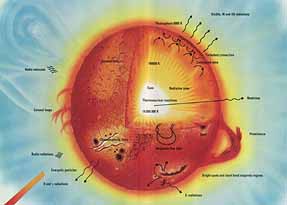
We may know our Sun (Our sun?) as it goes to sleep,
The sun went to sleep,or even as it is waking up
in a brilliant night dress,
That seemed to shorten,
as its light was seen less.
Until it had rested,
its weary warm head,
Within the cool blankets,
of moon glow, its bed!
-Linda A. Copp
The sun in the morning.But how well do we know our Sun? (this is probably the same problem every parent has with their child.) But keeping our discussion to the Sun; It is so scorching hot that we can't go near it, or peek into it to see what it is made of. This is not quite the truth.
Like a protective mother she rises and brings warmth to everything she touches.
Artists try to harness her beauty, scientists study to find her secrets.
Every being feels more alive when she is there sad when she is shrouded by a cloud.
She leaves each day with a promise to return that is never broken.
--By Bruce Patterson
Even as people reveal their true feelings when they become angry, any physical element shows its nature when it is very hot. The physics of it is: a hot body "feels" hot to us, and this heat comes to us as heat waves.
The light we see are waves of a particular length (or wavelength), and within them we see variations from blue (40 microns) to green to red (70 microns). One time when Newton passed white light through an optical prism, he found an image of a rainbow on the white screen nearby. This rainbow is the called "spectrum" of white light. You can also call it the signature of white light. Similarly when physical elements are heated at high temperatures, they begin to glow and emit waves, just like light, and that defines its own charateristic signature spectra. In the turn of the 19th century, enough progress had been made studying the signatures of Hydrogen and Helium at very high temperatures. (1000000 microns = 1 meter)
It was then possible to obtain signature of the heat waves coming from the sun and they began to show patterns that matched those of Hydrogen at high temperatures. This not only gave an idea of how hot the sun is (Its very hot!), but gave us an insight what is happening inside of it. The temperature on the sun is about 15 million degrees Celsius at its core.
At this temperature, as makers of the atom bomb also figured, many Hydrogen atoms can fuse into larger elements, thus producing a lot of energy. You see, the total mass of Hydrogen atoms is more than the mass of larger element produced. The remainder is released as energy in accordance with Einstein's relation that energy and mass are equivalent. We knew there was Hydrogen there and it was there at high temperatures. The patterns that matched were not exact, and what didn't match must have come from the heavier elements. You can also guess now that Sun has more hydrogen than of the heavier elements, as Hydrogen leaves heavier imprint on the signature of sun's heat waves than other elements.
So the theory was that Hydrogen fused to form Helium, and some Helium atoms further fused to form Carbon and so on. This theory is now backed by the signature patterns. We begin to appreciate how we have gone from visible light to make inference about the sun, which we can hardly look at. But, Sun is the Star of our solar system. Sun looks bright to us because it is so close to us. So the same story holds for all the stars that light up the night sky.
There are many unresolved questions. Will Hydrogen get exhausted? Remember some energy also comes from fusion of Helium atoms. How long will the sun last? How did it come to be in the first place. How old is it? There are many theories and each one was arrived at in its own peculiar way.
The sun went to sleep,
Within the cool blankets,
of moon glow, its bed!
Another day, Another time, Same blog.
No comments:
Post a Comment